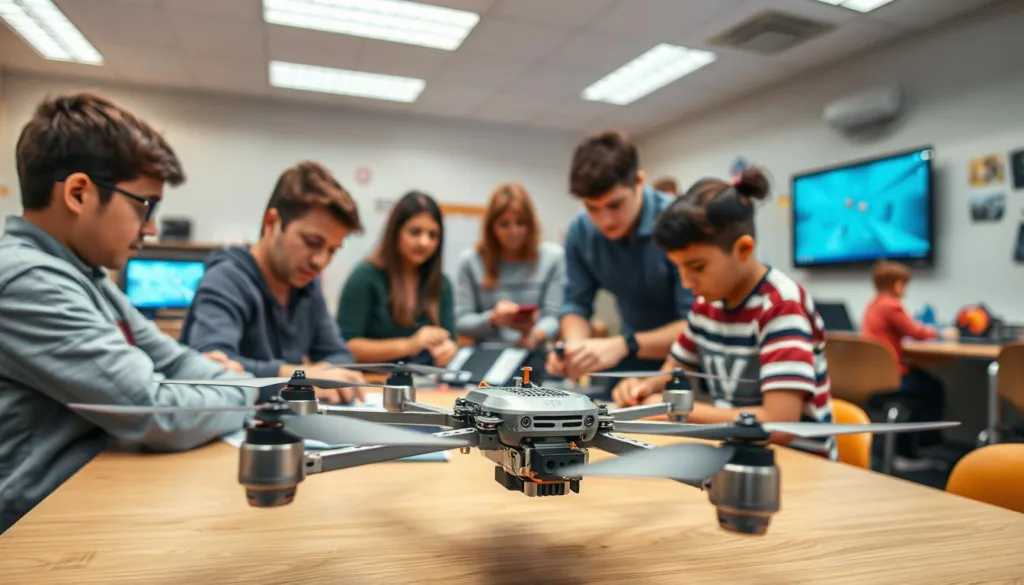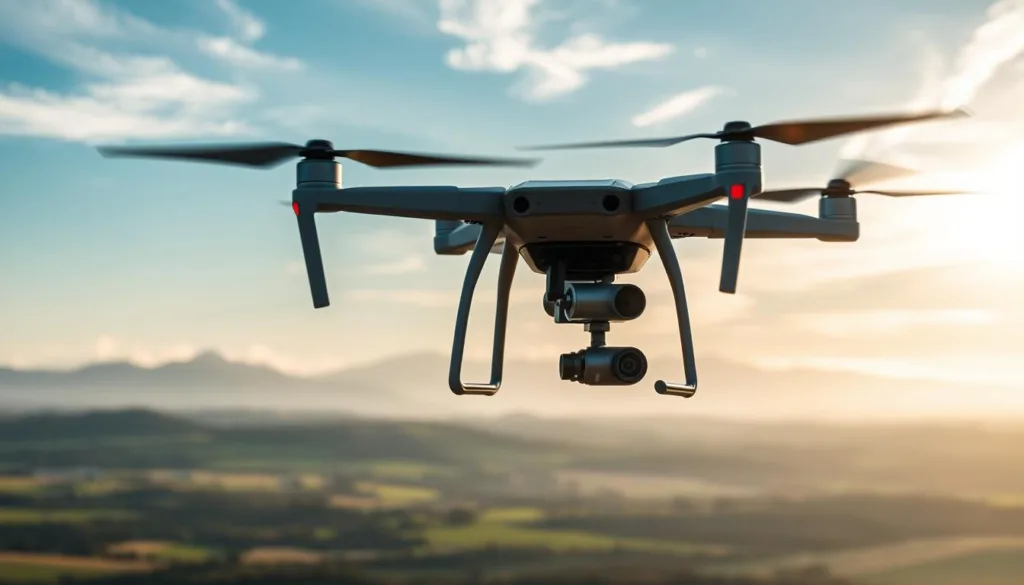As unmanned aerial vehicles reshape industries, early exposure to this technology gives young learners a career-ready edge. Cutting-edge simulators now let students master flight principles without expensive equipment or safety concerns. These virtual platforms create risk-free environments to explore aviation physics, coding basics, and creative problem-solving.
Educators nationwide are discovering how simulated training bridges classroom theory and real-world applications. Through interactive modules, learners grasp essential STEM concepts while developing spatial awareness and technical skills. This approach aligns with modern workforce demands, where over 150,000 U.S. jobs now involve aerial systems operation.
Schools implementing these solutions report increased student engagement across multiple subjects. From mapping geological formations to programming flight paths, the applications span science, math, and digital arts. Budget-friendly options ensure districts of all sizes can participate in this educational shift.
Key Takeaways
- Virtual training platforms eliminate physical risks while maintaining educational value
- Aerial system knowledge prepares learners for high-demand technical careers
- Flexible integration options work with existing STEM curricula
- Multidisciplinary applications cover physics, coding, and creative disciplines
- Scalable solutions accommodate varying budget levels
- Safety protocols address common administrative concerns
- Proven success stories demonstrate measurable student outcomes
Why Advanced Drone Flight Simulators Enhance School Training
Modern education demands innovative solutions that balance engagement with practicality. Flight simulation technology addresses both needs by creating immersive environments where learners master aerial operations without physical risks. These platforms turn theoretical concepts into tactile experiences, building confidence through repeated practice in digital settings.
Safer Skill Development
Virtual training removes hazards like collisions or weather-related accidents. Beginners can reset mistakes instantly, while instructors monitor progress through customizable dashboards. One educator noted: “Our learners attempt advanced maneuvers on day one – something impossible with physical devices.”
This method sharpens coordination and decision-making through instant feedback loops. Students internalize spatial relationships and physics principles faster when consequences are visual rather than destructive.
Budget-Friendly Tech Integration
School budgets stretch further with simulators eliminating repair costs and equipment replacements. SRIZFLY’s systems include firmware updates and dual warranty options, ensuring long-term value. Districts report 80% fewer unexpected expenses compared to traditional programs.
Unlimited virtual flight time means no dead batteries or delayed lessons. Classes progress consistently, whether practicing navigation patterns or coding autonomous routes. Year-round accessibility keeps STEM projects on schedule regardless of outdoor conditions.
Educators appreciate standardized assessment tools that track individual growth. From basic controls to programming challenges, every learner progresses at their pace while meeting curriculum benchmarks. This approach makes technical education inclusive and measurable.
Integrating “drone teaching tools for schools” into Your Curriculum
Educational institutions are finding powerful ways to blend aviation technology with core subjects. By connecting flight systems to existing lesson plans, educators create dynamic learning experiences that meet state standards while sparking curiosity. This approach turns abstract concepts into tangible challenges, helping learners grasp complex ideas through hands-on experimentation.

Aligning With STEM and Aviation Learning Objectives
The NextWave STEM program offers a proven model for grades 9-12 through their “Creation and Evaluation of Drones” course. Students tackle real-world scenarios like environmental surveys and infrastructure inspections, applying algebra and physics to optimize flight patterns. One teacher shared: “We’ve seen 40% higher retention rates in geometry since adding aerial mapping projects.”
| Subject | Traditional Methods | Drone-Enhanced Approach |
|---|---|---|
| Mathematics | Textbook equations | Flight path calculations |
| Science | Diagram studies | Wind resistance experiments |
| Technology | Software tutorials | Real-time coding adjustments |
Professional development programs help instructors master both technical skills and pedagogical strategies. Many districts start with single-subject pilots before expanding to cross-curricular projects. Arts classes now incorporate aerial photography, while history courses use mapping tools to analyze battlefield strategies.
“Our coding club members became math tutors after creating obstacle course algorithms for our Codrone Edu kits.”
Ready to transform your program? Let’s explore how Codrone Edu solutions can elevate your STEM offerings while meeting essential learning benchmarks.
Hands-On Learning: Simulated Flights and Coding Essentials
Classrooms transform into innovation labs when students pair virtual practice with real-world programming challenges. This blended approach lets learners master aerial operations through risk-free simulations before advancing to physical hardware. The Ryze Tello bridges this gap perfectly, offering affordable entry into both flight mechanics and computer science fundamentals.
Building Confidence Through Virtual Practice
Digital environments let young students crash-land prototypes without consequences. They learn throttle control and spatial navigation through instant feedback loops. One educator observed: “Our class attempts barrel rolls on day three – impossible with real devices.”
These simulations create measurable skill progression. Learners transition to physical devices only after demonstrating mastery of safety protocols and basic maneuvers. This method reduces equipment damage by 92% in first-year programs.
Coding Made Tangible
The Tello’s dual programming options meet diverse learning needs. Beginners use DroneBlocks’ drag-and-drop interface to create flight patterns. Advanced students write Python scripts for complex tasks like object recognition.
| Coding Concept | Beginner Project | Advanced Application |
|---|---|---|
| Loops | Square flight path | Automated grid mapping |
| Conditionals | Obstacle avoidance | Gesture-controlled navigation |
| Variables | Altitude adjustments | Wind compensation algorithms |
Real-time debugging teaches persistence when code doesn’t execute as planned. Students grasp cause-effect relationships seeing their instructions translate to aerial movements. One class created a weather station that adjusts flight paths based on live wind data.
These experiences make abstract programming concepts concrete. Learners gain technical skills while developing critical thinking abilities needed for STEM careers. The best part? All progress happens without costly crashes or safety concerns.
Real-World Applications: From Physics to Aerial Photography
When science leaps off the textbook page, learners grasp complex concepts through hands-on experimentation. Modern aerial systems bridge abstract theories and practical skills, offering two powerful educational lenses: physics exploration and visual storytelling. SRIZFLY’s simulation technology enhances both areas by providing safe, repeatable environments for discovery.

Demonstrating Fundamental Physics Concepts
Codrone Edu transforms flight into a floating laboratory. Students see Newton’s third law in action as rotors push against air molecules to achieve lift. “Watching motors adjust mid-flight to maintain stability makes physics click faster than any diagram,” notes a Georgia STEM instructor.
Advanced modules explore how temperature changes affect rotor efficiency or how gyroscopes counteract wind gusts. These tangible lessons connect equations to real-world outcomes, helping learners predict outcomes before testing theories in physical environments.
Exploring Aerial Photography and Map Reading
Elevated perspectives revolutionize how young minds document their world. Codrone Edu’s camera systems let teams capture school landmarks from angles impossible with handheld devices. Students stitch images into detailed maps, learning scale ratios and topographic symbols through projects they design.
One class tracked seasonal changes in local parks using monthly aerial surveys. Another compared historical neighborhood layouts with current land use patterns. These activities build geographic literacy while introducing careers in urban planning and environmental science.
Educators appreciate how SRIZFLY’s tools balance creative freedom with structured learning. As learners code flight paths or analyze aerial data, they’re not just operating devices – they’re solving problems that matter.
Engaging Classroom Activities and Interactive Lesson Plans
Transform your classroom into a buzzing tech lab with activities that blend excitement and education. These hands-on experiences turn theoretical concepts into memorable adventures, helping learners connect dots between screens and real-world applications.
Indoor Obstacle Courses and Competitive Challenges
Create adrenaline-packed learning stations using everyday items. Hula hoops become aerial gates, pool noodles transform into tunnel markers, and cardboard boxes serve as landing pads. Timed trials sharpen reflexes while teaching physics principles like momentum and angular velocity.
| Course Element | Learning Objective | Required Materials |
|---|---|---|
| Precision Landing | Throttle control | Cardboard targets |
| Barrel Roll Challenge | Aerodynamic principles | PVC pipe arches |
| Obstacle Slalom | Spatial reasoning | Pool noodle markers |
The Tello Boost Combo keeps classes running smoothly with triple batteries and quick-charge hubs. “Our students complete 3x more practice runs since switching to this system,” reports a middle school tech coordinator.
DIY Assembly and Electronics Fundamentals
Peel back the tech curtain by building devices from scratch. Young engineers compare brushed and brushless motors through tactile experiments. Component compatibility lessons emerge naturally when mismatched parts refuse to cooperate.
Essential concepts covered:
- Battery voltage vs flight time ratios
- Weight distribution effects on stability
- ESC calibration techniques
One class troubleshooted a rotor issue by testing different propeller sizes. “They discovered airflow dynamics without opening a textbook,” the instructor marveled. These projects turn abstract electronics theory into unforgettable ah-ha moments.
Conclusion
Educational landscapes are evolving rapidly, with aerial technology becoming a cornerstone of modern STEM programs. SRIZFLY’s simulation platforms offer schools a bridge between theoretical concepts and real-world technical mastery. These systems turn complex aviation principles into engaging challenges that spark curiosity across grade levels.
By integrating flight systems into curricula, educators prepare students for emerging fields where unmanned vehicle operation is essential. The Codrone Edu platform demonstrates this perfectly – learners develop coding expertise through flight pattern algorithms while grasping physics fundamentals through virtual wind tunnel experiments.
Successful implementation hinges on three pillars: teacher training, scalable technology, and ongoing support. Schools adopting comprehensive programs see measurable gains in problem-solving abilities and technical confidence. One district reported 68% higher participation in computer science electives after introducing simulated flight modules.
The true power of these tools lies in their adaptability. Young learners start with basic controller skills, progressing to advanced programming as they mature. This growth-focused approach ensures relevance from middle school robotics clubs to high school engineering courses.
Educators seeking reliable solutions find SRIZFLY’s approach particularly valuable. Their simulators eliminate physical risks while maintaining the excitement of hands-on experimentation. With customizable lesson plans and real-time progress tracking, teachers can focus on mentoring rather than equipment management.
Ready to bring aerospace education into your classrooms? Contact our team to explore how Codrone Edu solutions can elevate your STEM programs while meeting strict safety standards and budget requirements. Let’s build the next generation of innovators together – one simulated flight at a time.
FAQ
How do flight simulators ensure safety during student training?
Advanced simulators like Liftoff or DJI Flight Simulator provide risk-free environments where learners can practice maneuvers, crash protocols, and emergency responses without physical drones. This reduces accidents while teaching critical decision-making skills.
Are these tools affordable for schools with limited budgets?
Yes! Many programs offer discounted bundles for educators. For example, Robolink’s CoDrone EDU combines hardware, coding software, and lesson plans at accessible prices. Simulators also cut long-term costs by minimizing repairs or replacements.
Can drone activities align with state STEM standards?
Absolutely. Lessons often cover physics (thrust, aerodynamics), math (battery life calculations), and engineering (building/repairing units). Platforms like DroneBlocks integrate coding challenges that meet Next Generation Science Standards (NGSS).
How is coding taught using these devices?
Tools like Tello EDU and Scratch allow students to program flight paths, tricks, or sensor-based actions through block-based or Python coding. This builds logical thinking and problem-solving skills in interactive ways.
What real-world skills do students gain from drone programs?
Beyond piloting, learners explore aerial photography, 3D mapping, data analysis, and even drone journalism. These projects teach teamwork, technical literacy, and creative applications for industries like agriculture or filmmaking.
What classroom activities work best for beginners?
Start with indoor obstacle courses using micro-drones to boost hand-eye coordination. DIY assembly kits also let students study motor functions and circuitry basics. For older grades, timed coding challenges add competitive fun.
How do schools handle maintenance or repairs?
Most educational drones, such as Parrot Mambo, have modular designs for easy part replacements. Many providers include troubleshooting guides, and lessons often cover routine care like propeller checks or battery safety.



